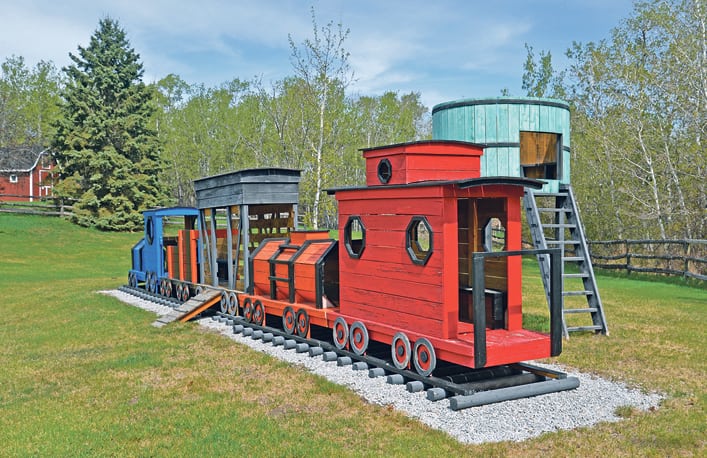The owner of a livestock trucking company says he technically doesn’t farm; he leaves that up to his kids
LACOMBE, Alta. — “Technically, I don’t farm,” says Murray Ebeling, who operates his livestock hauling business, Proudash Cattleliners Inc., from the family farm.
Ebeling’s wife, Candace, is also an experienced livestock trucker, but driving has taken a back burner. Instead, her energies are devoted to their family of four teenaged children and the farm, which includes a small herd of Braunvieh cattle, sheep, horses, laying hens, miniature pot-bellied pigs, miniature donkeys, dogs, cats and a huge yard.
“She’s a spare driver and still gets out now and then,” he said.
Read Also

Farming Smarter receives financial boost from Alberta government for potato research
Farming Smarter near Lethbridge got a boost to its research equipment, thanks to the Alberta government’s increase in funding for research associations.
Murray recalls that when the kids were small, “there were times when the car seat got strapped into the Sunkist Rocket”, his nickname for her bright orange rig.
“Carson’s the farmer,” Murray said about his 14-year-old son, who seeded 21 acres of barley and 17 acres of canola this spring with his line of vintage farm equipment.
Carson’s 19-year-old brother, Esten, did seed bed preparation with power harrows beforehand. It’s Carson’s second crop, and the barley went malt last year.
Esten works for a nearby custom farming operation, while daughter Harley, 17, drives packer for a construction company. She’s also the owner of a Brahma cow, Missy, which with its calf, Bruno, hangs out with the Braunviehs.
The youngest Ebeling, 13-year-old Grady, is a novice steer rider.
All the children raised and sold cattle for a few years through the Nebraska Multi 4-H Club, which gave them useful skills and income.
When they’re home “everybody helps do whatever,” Candace said, which could be doctoring cattle, herding sheep, fixing fence, repairing equipment or cutting grass.
“They’re learning lots in life”, said Murray, who shared a family rule: “don’t expect other people to pay for your dreams.”
All four children, including Grady, who’s still a ways away from driving, have bought their own vehicles.
The Ebelings bought their farm 13 years ago. It was just after a time when they had finally resigned themselves to the fact that it would never happen. Many of the farms they looked at didn’t meet their list of wants and needs. The ones that did were out of reach financially.
The Ebelings reluctantly sold the 20 cows Candace owned since before they married, which were pastured on rented land.
The couple were learning to be content as acreage owners and had just finished the home’s basement.
Then Candace saw a listing online that intrigued them. They decided it wouldn’t hurt to have a look. That look turned into their dream come true.
“Everything was here; just like you see it,” said Murray.
At the farm’s entrance is a curving paved driveway that winds through stands of poplar and fir to a lush green lawn with shrubs and flowers, a comfortable spacious house, barns, corrals and shops.
The house looks southwest to rolling pastures and fields: a picture postcard scene.
They bought the 91 acre farm in May 2005, when the country was still recovering from the BSE crisis that had broken out two years earlier.
A reminder of that sits on the lawn.

“It’s my BSE train,” Murray said about the project that kept him busy on the acreage.
“I was home a lot with my BSE kids, Carson and Grady.”
Cattle hauling jobs were few and far between until the industry started to recover after about 18 months.
Candace’s memories of trucking started early.
“I always wanted to drive trucks,” she said.
“On my first day of kindergarten I went to school in my uncle’s cab-over Kenworth.”
“It’s a memory from when she grew up on the farm at Etzikom in southern Alberta.
Murray taught her to drive when they were dating. They married in 1997 while on a six week safari in South Africa. Later that year he bought her the Sunkist Rocket.
“I drove until I started having kids in ’99,” she said.
Murray began his livestock hauling career in the summer of 1986 because of what he calls “a lucky break.”
A truck driver broke his leg playing baseball. The owner hired Murray to fill in. Then before too long, “I bought the boss’s truck. And then in ’92 I bought the company.”
He’s been trucking livestock for 33 years, primarily in central Alberta.
“I’m going to haul cattle until I think it’s time to quit.”


















